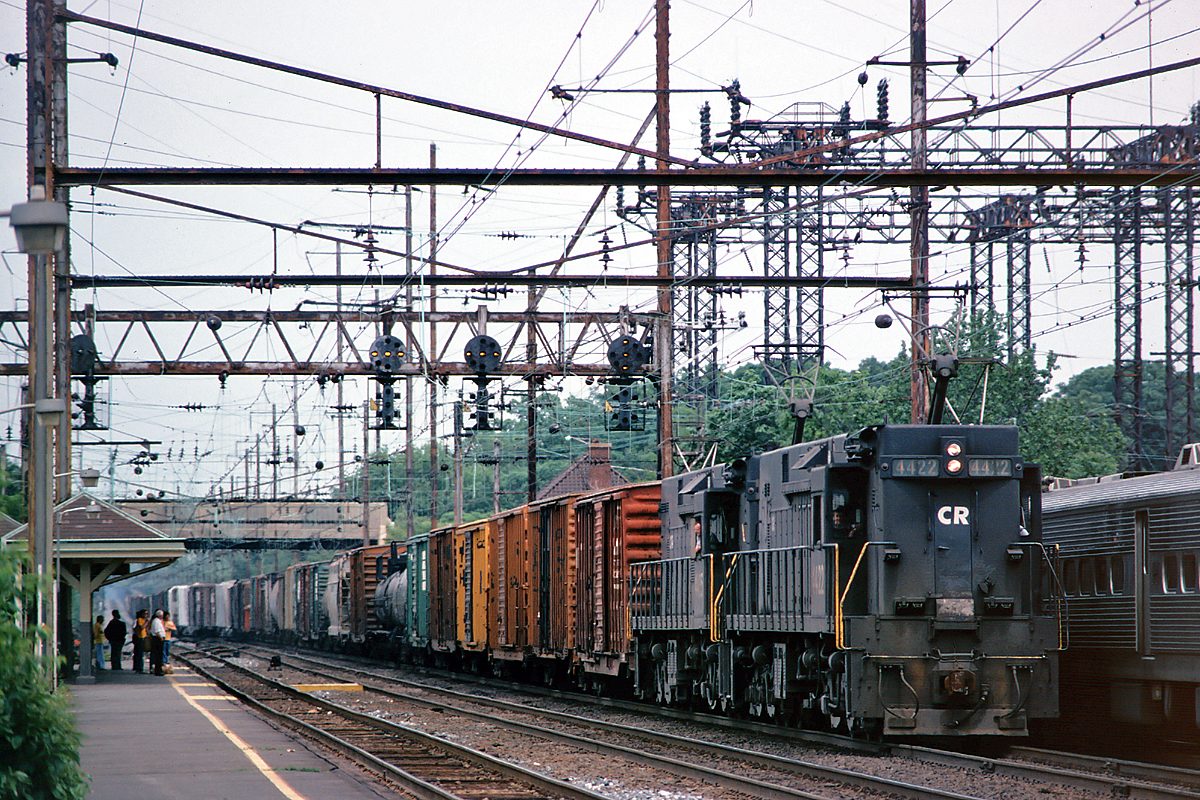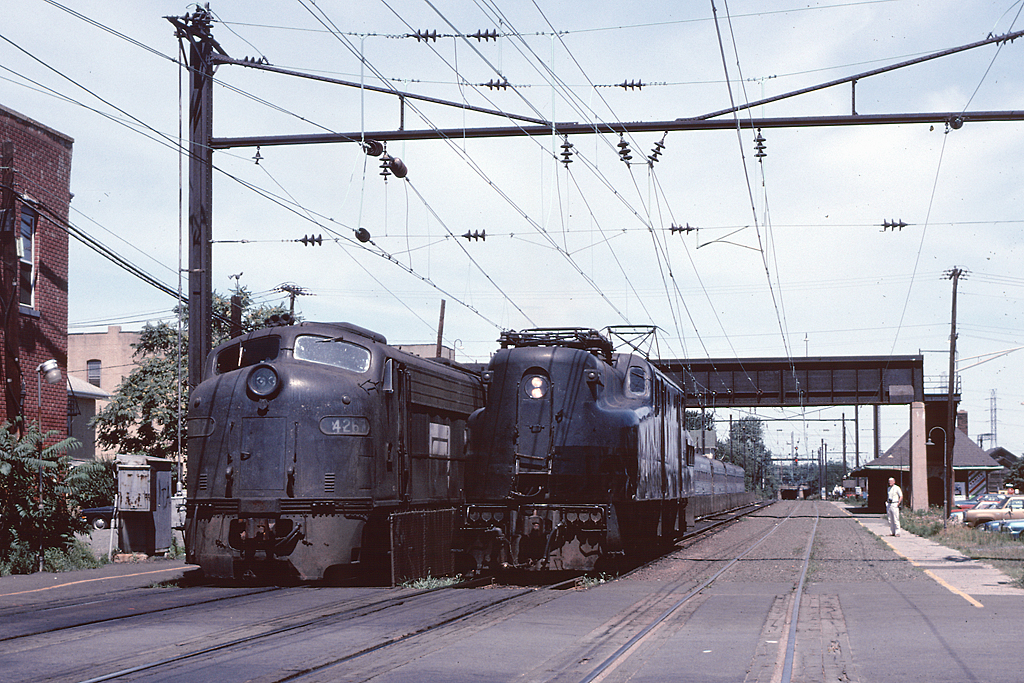"Hi, ho, hi, ho, it's off to work I go!"
After my, um, "interesting" first train ride (
Episode 6) I got a chance for another one.
Good thing! Train rides were the "crown jewel" of the training experience to me. What's better than riding on a train?
But first, some background. Another trainee assignment was to follow a locomotive through a "heavy" repair and then ride the first trip to see how it fares. I picked an ex-PC U33C that had become a "hangar queen" of sorts. It was waiting in pieces for parts to arrive. It sat outside the shop for a week. Finally, the parts arrived and the ex-EL machinists set to work fixing it.
As I recall, this particular locomotive needed four or five power assemblies. Not enough for a trip to the backshop but fairly major work for a small running repair shop. The ex-EL guys were sharp. They had had experience doing complete overhauls on the EL's GE U-boat fleet at Marion. A half dozen power assemblies was simple for them. They tolerated my questions as they worked. Removing the bad ones. Installing the good ones. Setting the fuel rack, etc.
Once all the work was done, it was time to fire it up. Despite being outside for a week, the batteries were in good shape. The 16 cylinder FDL engine slowly cranked over. Would it start? One cylinder fired. Woomph! Then a few others. Woomph, woomph, woomph! A big cloud of smoke filled the shop, but it was idling. Gene Wilder's voice popped into my head. "It's alive!" Very soon, the idling smoothed out and the smoke died down. Acrid diesel smoke was everywhere, but who cares? "It's aliiive!"
They moved the locomotive out to the load box. A load box is a "fake train". It a big box of resistors to which you connect the output of the locomotive's main generator. You can then power up the locomotive's diesel engine to full horsepower. Think of it as an electrical dynamometer for a locomotive.
Once they had the locomotive connected to the load box, they slowly warmed the engine up until they had it running in "notch 8" - full power! WOPWOPWOPWOPWOP! The exhaust sounded a bit like a helicopter blade going around - steady and sharp. They checked the engine speed. Right on 1050 RPM. They checked the voltage and the amperage going into the load box and adjusted for the generator efficiency. 3300 HP plus or minus a small amount. They checked for leaks, looked at the exhaust and gave the locomotive a good once-over. Everything was perfect. Time for this locomotive earn it's keep.
I don't recall if I had any sway in the decision or not, but the locomotive was assigned to a road freight headed toward Avon Yard in Indianapolis. COIN in Conrail terms. COumbus to INdianapolis. This was good. A real road train. Not some "peddler". Better yet, the train was called for the next morning. I could go home and get some sleep first!
The next day I arrived at the fuel pad about dawn and found my engine. It was paired with a GP38 which was going to be the lead unit. The crew came on board and I introduced myself. We headed out to pick up our train in the departure yard. The yardmaster told the crew we had a couple of bad orders to set out before we could depart. Great. How long's THAT going to take? It took two hours - ugh. I might never get out on the road.
Not to worry, we finally got our air test completed and we were off!
It was a great fall day! Sunny, dry and cool. The consist was arranged "elephant style" - nose to tail, with the trailing locomotive cab, the one I was in, facing forward. I sat in the engineer's seat where I could see the gauges, opened the side cab widow, and watched the world go by.
We headed out the north end of the yard onto the "Bradford side" main. It was the ex-PRR line to Chicago. Nearly all of it had been recently upgraded with new ties and welded rail, making for a very smooth ride. Along the way, we passed a rail gang working on finishing up the upgrading of the route.
 |
| GP38-2 led train east of Buckeye on PRR panhandle. This line would late be sold off. |
Conrail was spending bucket loads of money on equipment and track back then, trying to resurrect a corpse. The thought was, if the railroad was in a good state of repair, it could make money. It turned out there was more wrong with Penn Central than just deferred maintenance. But little did I know, riding that day, that this freshly rebuilt mainline would be ripped up in just a few years in an attempt to make the route structure fit the profitable traffic in the deregulated era that was coming.
But, this particular day on this particular train, all was right with the world. We crawled up the hill toward Bradford, then onto Union City Ohio where we joined the old Big Four mainline. From there were rolled through Muncie Indiana and on toward Indianapolis. So far, a flawless trip. For long stretches, we held a steady 50 mph, the fastest were were authorized to go.
I would occasionally check the load meter and write down the value of the current going to the traction motors. I wanted to be able to figure out what the load should be at various speeds when I got back home. Always the engineer....
The line into Indy was also freshly rebuilt, but they hadn't worked the road crossings completely yet. At the first one, the big U-boat bounced up, launching me from my seat cushion, and proceeded to bounce up and down for the next few hundred feet before the suspension damped it out. Didn't see that coming! The thrill ride was repeated at every crossing on the line. I noticed the GP38 in the lead didn't seem to bounce quite as much. Later in my career, I'd learn quite a bit more about truck design and ride quality, but this was an interesting introduction.
Just outside of Indy, an approach signal, then a stop. We were being held out for traffic at the yard on the other side of town. It was getting to be late afternoon and the crew was starting to get short on their 12 hour work limit. But, not to worry! Finally, a high green!
The engineer notched out. The GP38 dug in and started to pull. My U-boat was slowly thinking about loading up. That's how they were. The difference between the two was that one had a two stroke diesel that could get going quickly and the other had a turbocharged four stroke engine that needed time for the turbo to get spinning before there was enough air to pour in more fuel and get thinks moving. This created a problem. It only took the GP38 20 seconds to get to full load, by which time it was slipping and overheating its traction motors. The GE took a full minute and a half. After a couple of attempts at starting the train, the head end brakeman came back to make sure the GE was loading at all. I told him it seemed okay to me and then engineer attempted another start so he could see what was going on with his more experienced eyes.
He radioed the engineer that the trailing unit was okay, just loading slowly. They had a simple fix. They "isolated" the lead locomotive by snapping the isolation switch. This allowed the locomotive to control all the other locomotives, as it had, but disconnected that locomotive from responding.
The engineer notched out and slowly the big U-boat started to load. After about a minute it sounded like it was starting to dig in. The brakeman radioed "now!" and the engineer snapped the isolation switch on the lead unit. A geyser of exhaust shot out of it's stack as the diesel engine revved rapidly from idle to full speed, full load. The GP38 dug in and the train started to move. Slowly we gained speed and crawled by the virtual ruins of the old Union Station in downtown Indy, arriving at Avon yard a short time later. QED.
It was dusk now and I got jitney ride back to downtown Indianapolis. I found the Greyhound station and bought a ticket for Columbus. I had a couple hours to kill, so I wandered around the downtown area a bit, walking over to the old Union Station.
Greyhound? What was I thinking! Amtrak's National Limited comes through here in the evening on it's way from Kansas City to New York. Am I too late? I go into the nearly deserted station. What was a massive, ornate, first rate passenger station has nearly been abandoned in place. A very sad and lonely place. I find the ticket office. The train comes by in about an hour - and is on time! I buy a ticket, head back out and return my Greyhound coupon and return to Union Station. Hot damn! Two train rides in one day!
What took all day on the freight train, took four hours in reverse on Amtrak. To be fair, the Amtrak train used the old PRR-panhandle line, which was shorter, but had very little traffic. It, too would be torn up in the next couple of years.
The National Limited was freshly equipped with completely rebuilt, spotless "heritage" equipment - HEP equipped and nearly new F40PH-2 locomotives. A very nice train that had not trouble holding down 80 mph all the way back "home" - on time!
A glorious day with a fitting end! Maybe this IS the career for me!






















.bmp)


